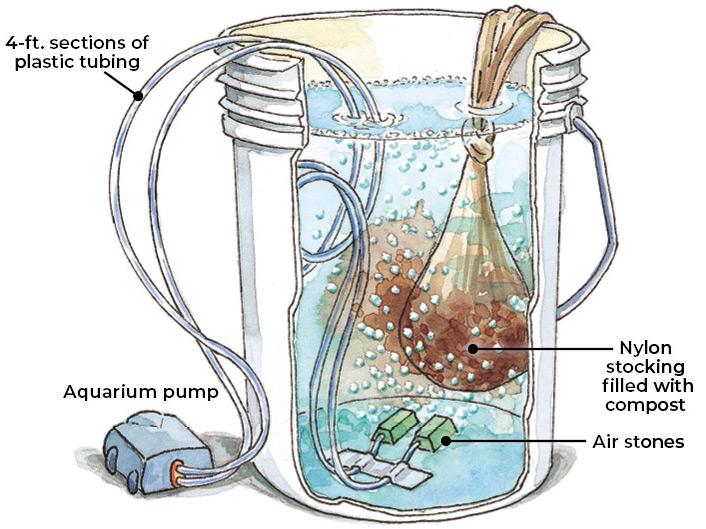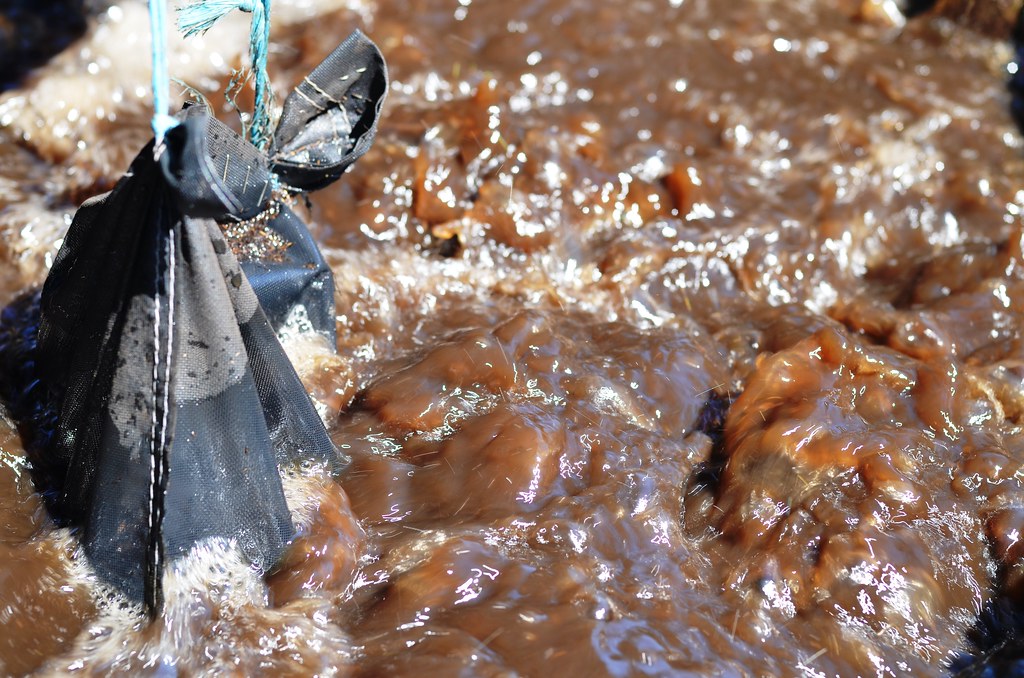Compost is full of beneficial microorganisms and nutrients. You can take it a step further by soaking it in oxygenated water. This process, called “compost tea,” extracts the microorganisms and soluble nutrients into an aqueous “tea” solution.
The goal of Compost Tea is to introduce nutrients, fungal colonies, and beneficial bacteria into either the soil or foliage of a cannabis plant to support growth and protect it from harmful diseases, thereby encouraging the growth of larger, stronger, and more resilient plants.
Compost tea should never be a 100% substitute for nutrients, but it can be a great addition to other nutrients.
You can add compost tea to cannabis plants by:
- Spray on the leaves
- Pour on the ground
When you apply it to the soil, you contribute to the soil’s food web by introducing a healthy population of microorganisms that are naturally aerobic (life that relies on oxygen). These organisms hold nutrients, aerate the soil, aid in water retention, increase the nutrient uptake of the cannabis plant, aid in the formation of healthy roots, and help prevent disease.
However, the benefits of compost tea are controversial in the agricultural world. Many gardeners report quality results from using it, while others see no greater benefit than using pure compost. The uncertainty lies in whether a forming and developing population of microorganisms in the tea can actually benefit the plants and prevent diseases.

Compost tea recipe for cannabis plants
A healthy compost tea removes soluble nutrients and microorganisms from the compost, including bacteria, fungi and protozoa.
Here are five key compost tea ingredients to create a successful tea that works best for cannabis plants.
1. Compost: A healthy compost should have a large population of microorganisms and nutrients, and sourcing it locally ensures that these organisms are local pathogens. Compost containing developed mycelium populations (fungal colonies) aids in the development of fungal growth in the tea.
2. Worm Casting: This by-product, expelled by a worm after digestion, provides a high density of nutrients in a broken down, refined form that is readily available to plants. Worm casting also introduces microorganisms.
3. Fish Hydrolyzate: This is made from fish and crustaceans to create a nitrogen-dense product. Crustacean exoskeletons also contain chitin, which acts as an immune booster for plants. Fish hydrolyzate also helps nourish and increase fungal populations.
4. Kelp: This serves as a food source for fungi that develop during the brewing of the tea. It is also believed to provide a surface for fungal colonies to attach and develop on.
5. Molasses: Serves as a food source for bacteria that develop during the brewing of the tea.
How to prepare the compost tea in 5 steps.
1. Build a compost tea brewer
Before building a compost tea brewer, you need to consider the size of your cannabis garden. Most growers use a 5-gallon bucket. On the outside of the bucket, you need an air pump connected to an aerator device at the bottom of the bucket. The aerator and air pump oxygenate the water to allow microorganisms to breathe.
You will also need a mesh bag to place the ingredients for the tea. While you can also buy pre-made compost tea brewers, you can also easily make your own inexpensively.

2. Create a schedule
Brewing tea takes time, so figuring out when you plan to use the tea is important. Most teas generally take 24-36 hours to brew. You should not let your tea steep for too long as the populations of the microorganisms will develop to a point where they no longer have enough oxygen or space to live and will begin to die, affecting the quality of the compost tea.
Only start with a tea if you can use it within 36 hours of brewing. When used as a spray, apply to the leaves in the evening or in the morning at a low temperature and away from direct sunlight. During this time, the stoma (stomata-pores in the leaves of the plant) are also open to absorb nutrients
3. Fill the compost tea bag
When making your first tea, don’t overcomplicate it and keep it simple. If you’re using city water, let it rest and breathe beforehand to allow the chlorine to break down. Once your tea is brewed, keep it out of direct sunlight and make sure the air pump is running and oxygen is being pushed through the water.
Easy DIY Compost Tea Recipe
| Non-chlorinated/filtered or rainwater | Enough to fill a 5-gallon bucket |
| Organic Compost | 2 cups |
| Worm Castings | 1/2 cup |
| Blackstrap molasses | 1 Tablespoon |
| Liquid Kelp Fertilizer | 1 Tablespoon |
| Liquid Fish Fertilizer | 1 Tablespoon |
4. Brew the compost tea
There are several products that can be added in the middle of the brewing process, towards the end or just before use: food for bacteria and fungi can be added halfway through the brewing process to increase the growth of microorganisms; Products such as seaweed and actinovates(biological fungicides) can be added before the tea is applied to the plants for additional benefits.
5. Applying compost tea to cannabis
The tea can be applied to roots or as a spray to the leaves of cannabis plants. Dilute the tea with water in a ratio of about 1:20 when applying (pouring) directly to the roots. Regular compost tea cannot harm or burn your plants, so you can also use a high dose freely. As a foliar spray, Compost Tea is usually diluted 1:2 with water. Do not use compost tea with drip irrigation as they will clog the lines over time.
Benefits of Organic Fertilizers for Cannabis Plants:
One of the best things about organic fertilizers is that they improve the soil and the quality of your plants at the same time.
Other advantages:
The slow release of nutrients protects plants from too many nutrients
Over time, organic fertilizers will improve the quality and variety of life in the soil
Improved aeration and water retention in the soil
Renewable and sustainable
Organic matter stays in the soil with less risk of nutrient runoff
Some growers are also finding that growing organically improves the flavour profile of the finished product and increases yields.
The fertilization process can repeat itself year after year as the soil continually improves – next year your soil will be even better than this year.
Using organic products is also great if you want to be more in tune with your natural surroundings. Organic fertilizers are readily available from renewable sources and are an environmentally friendly option.
Disadvantages of organic nutrients for cannabis plants:
There are a few complications when working with organic fertilizers. The main problem is that when your cannabis plant has a nutrient deficiency, it takes longer for the plant to absorb powdered organic nutrients, which can increase the damage of a deficiency to the plant. Liquid nutrients act much faster.
Other cons:
It takes longer to be absorbed by the plants
Need microorganisms to break down nutrients, which can slow down with deeper ones
May attract insects and pests


Hello. fantastic job. I did not anticipate this. This is a fantastic story. Thanks!
Thx for the recipe, worked amazingly well on my outdoor plants.